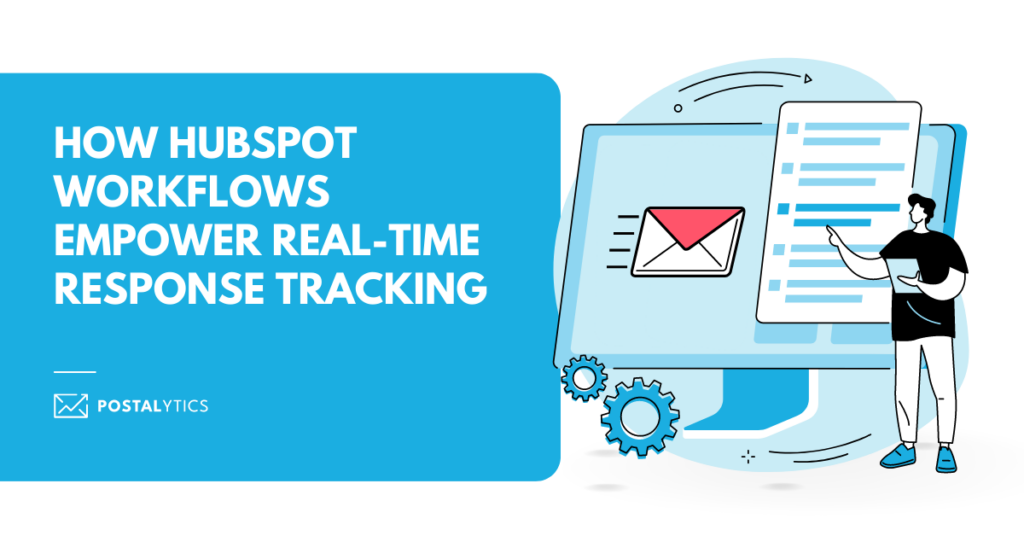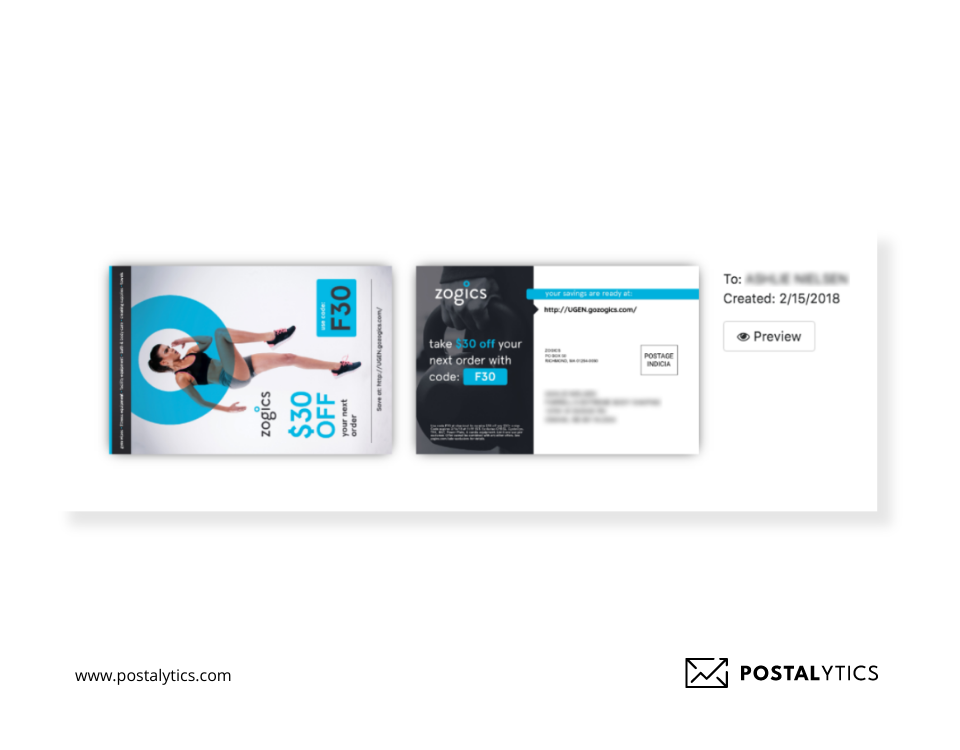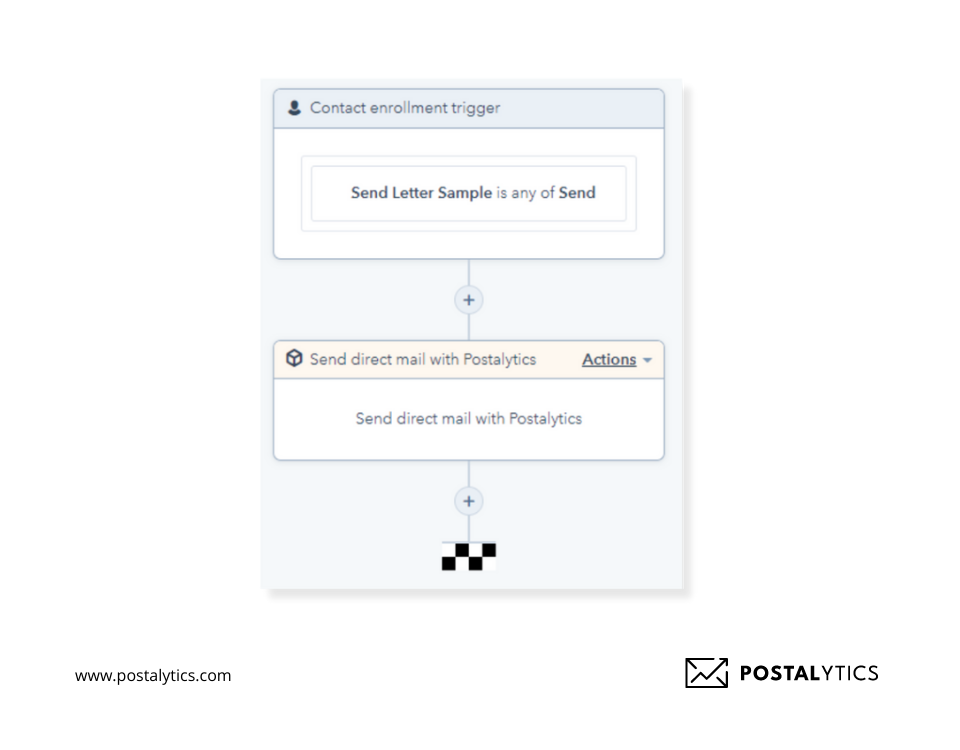
You’ve just sent out an amazing direct mail campaign.
Now, you’re eager to see the results. But the wait to discover if your campaign succeeded is only beginning. Sometimes it takes weeks; sometimes it takes months. What if you could receive performance data immediately?
Response tracking gives you that crucial information. It makes tracking direct mail as easy as monitoring your email campaigns. It helps you understand who received your mail pieces if they scanned your QR code or utilized your pURL, and how they navigated on your landing page.
Postalytics makes this response tracking simple. By integrating with HubSpot, you can take advantage of both platforms.
Let’s understand how you can activate real-time response tracking with this integration.
What We’ll Cover:
Understanding HubSpot Workflows
Since Postalytics integrated with HubSpot, there have been many updates on both platforms. Our integration is now even more robust, and we offer new-generation Premium integrations to our customers.
With this integration, you can create automated workflows and share data easily. For example, you can set up a workflow where the moment the recipient gets your direct mail, it triggers an email campaign for nurturing the prospect further.
There are many more great features. You can;
- Import lists from HubSpot Contacts for smart send campaigns,
- Send triggered direct mail from HubSpot using workflows,
- Sync response event status codes for each campaign to HubSpot for additional automation or response history storage.
Here’s how the integration becomes more functional and effective when switching to the premium version.
Why are HubSpot Workflows a Must-Have?
Setting up HubSpot workflows can make tracking your direct mail campaigns as easy as tracking your email campaigns. You can save your team time by automating many tasks and setting up triggers.
Here are four key reasons why you should set up HubSpot workflows.
Seamless Integration
Instead of using your CRM or direct mail or email tools in silos, you can bring them together with HubSpot workflows.
You can integrate these tools into your marketing stack and automate many tasks. You can automate the deployment of your campaigns, or you can trigger specific tasks. For example, you can trigger a task for “designing for direct mail campaign” 10 days before launching a new product or announcing a festive deal.
You can share data between different tools so your team can access important information when needed. This frictionless sharing reduces email overload when you ask someone to send an Excel file or a Google doc.
Real-time Response Tracking
Instead of relying on various intermediaries to provide data on campaign responses, you can get real-time data on direct mail tools like Postalytics.
For example, when your mail piece is scanned at different postal stations, this data gets transmitted to Postalytics via the USPS Intelligent Mail Barcode System. Using this data, you can find out whether it’s in transit, at the destination facility, or received by your prospect.
Using HubSpot workflows, you can send this data to your CRM or tool of your choice. This functionality makes the transition easy; your team can access data anywhere.
You can use these workflows to dictate further actions or optimize your future campaigns.
Measures Response Data
Many businesses now include pURLs and QR codes in their direct mail pieces to bring their prospects online. Instead of just sharing a discount code, you can include a QR code that the prospect can scan through their smartphone and use to make a purchase.
Businesses can use this to track respondents online and understand the actual effectiveness of their direct marketing efforts.
With HubSpot workflows, you can share all this data with your CRM and find out those prospects that are most interested in your campaigns and further nurture them towards conversion.
Refine Marketing Campaigns
Even if you generate great results from your direct mail campaigns, it’s a good practice to keep optimizing your campaigns.
With the data you get from Postalytics and the triggers you set up through HubSpot workflows, you can regularly analyze your marketing initiatives.
For example, you might find that a particular section of your list loves getting your direct mails, but a segment neither responds nor interacts with your campaigns.
You can try out two options – (i) take this segment out of your mailing list or (ii) send different variations of campaigns to them and see if the problem was improper targeting.
How HubSpot Workflows Empower Real-time Response Tracking?
To set up HubSpot workflows that do most of the work for you, here’s a process you can follow.
Segment a List
Before you start working on your direct mail campaign, narrow down your audience and segment a list.
You can create a mailing list with multiple criteria like a fixed age, income, location, or gender group. You can segment a list based on previous customer actions to make your targeting even more effective. For example, those who have downloaded an ebook from your website might be more inclined to subscribe to your newsletter.
Create these filters with HubSpot workflows and finalize a laser-focused mailing list. Every customer interaction or change made in your CRM will automatically reflect in your list, so you continually have updated data.

You can then import this list to Postalytics.
Design Your Workflow
Businesses increasingly want to create multi-touch campaigns to target customers and move them toward conversions seamlessly.
That’s where HubSpot workflows can make the job easier. For example, Zogics, an ecommerce company, uses Postalytics/HubSpot integration to set up workflows that automate postcard mailing and track engagement per contact.

It allowed their team to create personalized, multi-touch campaigns for specific audiences. The integration helped them achieve a 500% increase in ROI along with higher engagement and order quantity.
Here’s what a sample workflow looks like while using this integration.

You can create workflows for different activities and campaigns that can be automated and do not require any manual intervention. Here’s a detailed guide on how to set up these workflows.
Send Out Your Mail
You have poured all your effort into targeting the correct mailing list. You have designed an appropriate workflow. Now, you can start deploying your direct mail campaign.
Postalytics allows you to check the addresses before sending them, so you don’t waste money delivering mail to the wrong address. As we are certified by the USPS through Coding Accuracy Support System (CASS), we can access the current mailing address information from USPS.
You can run your mailing list through this check, which will mark the addresses that are not valid as “invalid.” Subsequent mailings are not sent to these addresses, keeping your mailing list updated.
Once you have verified everything, you can deploy your direct mail through Postalytics by ensuring you have enough credits in your account.
Track Responses with HubSpot Timeline
You can get response codes sent to HubSpot via Postalytics. Here’s a list of the important codes you need to know:
- InTransit: The mail piece is being processed at the origin facility
- InLocalArea: The mail piece is being processed at the destination facility
- Processed For Delivery: The mail piece is at the nearest postal facility and is ready for delivery.
- Re-routed: The mail piece is re-routed to a different address because of an error.
- Returned to Sender: The mail piece is returned to the sender because of an error.
- pURL Opened: The recipient has visited the pURL.
- pURL Completed: The recipient has achieved the goal on the pURL.
- Error: The mail piece is not created due to an error.
Measure and Optimize Your Campaign
You can only improve what you measure. With advanced tracking tools that platforms like Postalytics provide, you can track your direct mail campaigns’ online activity and response rate.
Based on this data, you can optimize your campaigns further. For example, if you find people in a specific demographic criteria respond well to your direct mails, you can try to include more people from that segment.
You can even set up Postalytics/HubSpot workflows to fix a scheduled time for analysis after the campaign has been deployed.
Track With Postalytics/HubSpot Workflow
Whether you want an easy way to manage your data across different apps or you want to track the different stages of your direct mail campaign, Postalytics/HubSpot integration makes it possible.
You can set up workflows to trigger campaigns, import mailing lists without entering data manually, and easily create multi-touch campaigns. It’s direct mail, done right.
To find out more about how you can utilize this workflow, get in touch with us today.
About the Author

Dennis Kelly
Dennis Kelly is CEO and co-founder of Postalytics. Dennis joined Boingnet, the predecessor to Postalytics, in 2013. Boingnet was focused on providing print and direct mail marketing service providers the ability to add digital marketing channels to their direct mail campaigns. Postalytics is Dennis’ 6th startup. He has been involved in starting and growing early-stage technology ventures for over 30 years and has held senior management roles at a diverse set of large technology firms including Computer Associates, Palm Inc. and Achieve Healthcare Information Systems.
